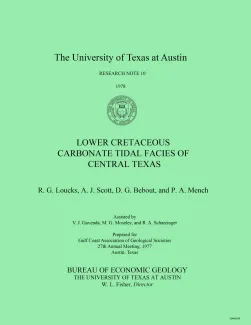Get the Publication
Abstract/Description:
In Texas, the Lower Cretaceous was deposited on an extensive broad, flat platform which extended from the Stuart City shelf margin on the downdip or seaward side to the area of Abilene in North Texas on the updip or landward side (fig. 1). Shallow-water shelf carbonate deposition, which took place over an area of more than 160 thousand square miles, was influenced by three major structural elements-the more rapidly subsiding McKnight and North Texas/Tyler Basins and the more positive Llano uplift. Depositional patterns on this platform were controlled by these structural elements as they affected deposition by a transgressing sea. The carbonates observed on this field trip in the Austin area were most affected by the positive Llano uplift and the subsiding North Texas/Tyler basin.
Lower Cretaceous rocks of Aptian and Albian age (fig. 2) are well exposed in the Central Texas area, in which the city of Austin lies. The section representing the Aptian and lower part of the Albian is characterized by a considerable amount of sandstone and shale interbedded with the more abundant limestone. Exposed here are the Sycamore Sandstone (equivalent to the subsurface Hosston Sandstone and Sligo Limestone), the Pearsall Formation (Hammett Shale and Cow Creek Limestone), and Glen Rose Limestone (characterized by significant quantities of shale). The terrigenous elastics were derived from the subareally exposed Llano uplift. In contrast, rocks of the upper part of the Albian consist almost entirely of limestone and contain only minor amounts of shale. During this time, the Llano uplift was entirely covered and was not contributing terrigenous sediment to the Fredericksburg/Edwards carbonates.
